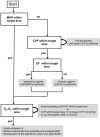Feasibility and beneficial effects of an early goal directed therapy after cardiac arrest: evaluation by conductance method
- PMID: 33674623
- PMCID: PMC7935910
- DOI: 10.1038/s41598-021-83925-3
Feasibility and beneficial effects of an early goal directed therapy after cardiac arrest: evaluation by conductance method
Abstract
Although beneficial effects of an early goal directed therapy (EGDT) after cardiac arrest and successful return of spontaneous circulation (ROSC) have been described, clinical implementation in this period seems rather difficult. The aim of the present study was to investigate the feasibility and the impact of EGDT on myocardial damage and function after cardiac resuscitation. A translational pig model which has been carefully adapted to the clinical setting was employed. After 8 min of cardiac arrest and successful ROSC, pigs were randomized to receive either EGDT (EGDT group) or therapy by random computer-controlled hemodynamic thresholds (noEGDT group). Therapeutic algorithms included blood gas analysis, conductance catheter method, thermodilution cardiac output and transesophageal echocardiography. Twenty-one animals achieved successful ROSC of which 13 pigs survived the whole experimental period and could be included into final analysis. cTnT and LDH concentrations were lower in the EGDT group without reaching statistical significance. Comparison of lactate concentrations between 1 and 8 h after ROSC exhibited a decrease to nearly baseline levels within the EGDT group (1 h vs 8 h: 7.9 vs. 1.7 mmol/l, P < 0.01), while in the noEGDT group lactate concentrations did not significantly decrease. The EGDT group revealed a higher initial need for fluids (P < 0.05) and less epinephrine administration (P < 0.05) post ROSC. Conductance method determined significant higher values for preload recruitable stroke work, ejection fraction and maximum rate of pressure change in the ventricle for the EGDT group. EGDT after cardiac arrest is associated with a significant decrease of lactate levels to nearly baseline and is able to improve systolic myocardial function. Although the results of our study suggest that implementation of an EGDT algorithm for post cardiac arrest care seems feasible, the impact and implementation of EGDT algorithms after cardiac arrest need to be further investigated.
Conflict of interest statement
JR has received honoraria from Edwards Lifesciences (Irvine, CA, USA) for giving lectures. BB has received honoraria from Pulsion Medical Systems (Feldkirchen, Germany) and Edwards Lifesciences (Irvine, CA, USA) for giving lectures. MG has received honoraria from GE Healthcare (Helsinki, Finland) and Pulsion Medical Systems (Feldkirchen, Germany) for giving lectures. No other author has a conflict of interest with regard to any device employed in this study.
Figures






Similar articles
-
Evaluation of remote ischaemic post-conditioning in a pig model of cardiac arrest: A pilot study.Resuscitation. 2015 Aug;93:89-95. doi: 10.1016/j.resuscitation.2015.05.019. Epub 2015 Jun 4. Resuscitation. 2015. PMID: 26051813
-
Periodic acceleration (pGz) CPR in a swine model of asphyxia induced cardiac arrest. Short-term hemodynamic comparisons.Resuscitation. 2008 Apr;77(1):132-8. doi: 10.1016/j.resuscitation.2007.10.018. Epub 2007 Dec 31. Resuscitation. 2008. PMID: 18164796
-
[Effects of mild hypothermia on β-adrenergic signaling pathway in a cardiac arrest swine model].Zhonghua Wei Zhong Bing Ji Jiu Yi Xue. 2018 Feb;30(2):134-139. doi: 10.3760/cma.j.issn.2095-4352.2018.02.008. Zhonghua Wei Zhong Bing Ji Jiu Yi Xue. 2018. PMID: 29402362 Chinese.
-
Inhibition of nitric oxide synthases, but not inducible nitric oxide synthase, selectively worsens left ventricular function after successful resuscitation from cardiac arrest in swine.Acad Emerg Med. 2015 Feb;22(2):197-203. doi: 10.1111/acem.12575. Epub 2015 Jan 29. Acad Emerg Med. 2015. PMID: 25639298
-
Distinct properties and metabolic mechanisms of postresuscitation myocardial injuries in ventricular fibrillation cardiac arrest versus asphyxiation cardiac arrest in a porcine model.Chin Med J (Engl). 2014;127(14):2672-8. Chin Med J (Engl). 2014. PMID: 25043088
Cited by
-
Postresuscitation pleth variability index-guided hemodynamic management of out-of-hospital cardiac arrest survivors: A randomised controlled trial.Resusc Plus. 2025 Mar 19;23:100933. doi: 10.1016/j.resplu.2025.100933. eCollection 2025 May. Resusc Plus. 2025. PMID: 40230365 Free PMC article.
-
Development and Validation of the CVP Score: A Cross-Sectional Study in Greece.Healthcare (Basel). 2023 May 25;11(11):1543. doi: 10.3390/healthcare11111543. Healthcare (Basel). 2023. PMID: 37297683 Free PMC article.
References
-
- Salcido DD, Stephenson AM, Condle JP, Callaway CW, Menegazzi JJ. Incidence of rearrest after return of spontaneous circulation in out-of-hospital cardiac arrest. Prehosp. Emerg. Care Off. J. Natl. Assoc. EMS Phys. Natl. Assoc. State EMS Directors. 2010;14:413–418. doi: 10.3109/10903127.2010.497902. - DOI - PMC - PubMed
Publication types
MeSH terms
LinkOut - more resources
Full Text Sources
Other Literature Sources
Medical
Research Materials

